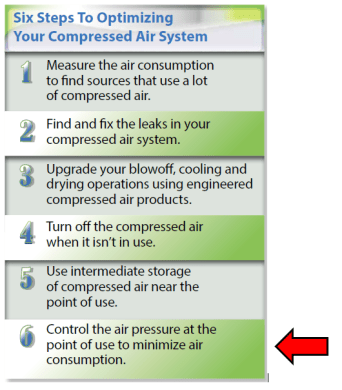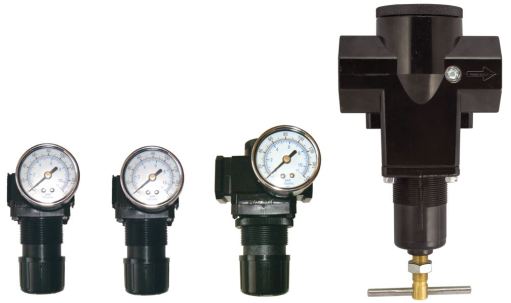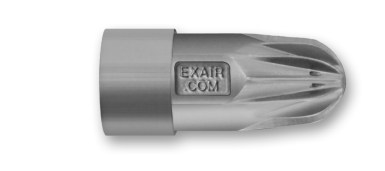
Since air compressors use a lot of electricity to make compressed air, it is important that you use it as efficiently as possible. EXAIR generated a chart with six simple steps to optimize your compressed air system. Following these steps will help you to cut overhead costs and improve your bottom line. In this blog, I will cover the sixth step; controlling the air pressure at the point of use.

One of the most common pressure control devices is called the Regulator. It is designed to reduce the downstream pressure that is supplying your system. Regulators are commonly used in many types of applications. You see them attached to propane tanks, gas cylinders, and of course, compressed air lines. Properly sized, regulators can flow the required amount of gas at a regulated pressure for safety and cost savings.
EXAIR designs and manufactures compressed air products to be safe, effective, and efficient. By replacing your “old types” of blowing devices with EXAIR products, it will save you much compressed air, which in turn saves you money. But, why stop there? You can optimize your compressed air system even more by assessing the air pressure at the point-of-use. For optimization, using the least amount of air pressure to “do the job” can be very beneficial and practical.

Why are regulators important for compressed air systems? Because it gives you the control to set the operating pressure. For many blow-off applications, people tend to overuse their compressed air. This can create excessive waste, overwork your air compressor, and steal from other pneumatic processes. By simply turning down the air pressure, less compressed air is used. As an example, a model 1100 Super Air Nozzle uses 14 SCFM of compressed air at 80 PSIG (5.5 bar). If you only need 50 PSIG (3.4 bar) to satisfy the blow-off requirement, then the air flow for the model 1100 drops to 9.5 SCFM. You are now able to add that 4.5 SCFM back into the compressed air system. And, if you have many blow-off devices, you can see how this can really add up.
In following the “EXAIR Six Steps To Optimizing Your Compressed Air System”, you can reduce your energy consumption, improve pneumatic efficiencies, and save yourself money. I explained one of the six steps in this blog by controlling the air pressure at the point of use. Just as a note, by reducing the pressure from 100 PSIG (7 bar) to 80 PSIG (5.5 bar), it will cut your energy usage by almost 20%. If you would like to review the details of any of the six steps, you can contact an Application Engineer at EXAIR. We will be happy to help.
John Ball
Application Engineer
Email: johnball@exair.com
Twitter: @EXAIR_jb